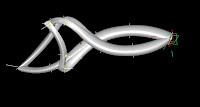




Vertex issue is becoming more resolved! (by constructing curves based off of a coordinate system that's x direction is the centroid of the endpoints of two lines tangent to the curves meeting at the vertex, a clean z-print tectonic joint is crafted)


the height attractor can allow local swells or bulges in the component_one option for how to use this could be - if there is a need for more private space, a swell can create a more intimate spatial condition - still, I don't really have any enclosure - working on this
I am working on generating a set of different surface effects for the
component - last class the component was very structural
now I want to see how is can enclose space - with the GCT file I have
attached, I want to be able to populate the component based
on parameters - similar to the area script you sent us early on in the
semester - however, I would like to do this in relation
to a point - this way I am thinking I can populate different instances of
generating curves, and on top of these, generate different
instances of my surfacing techniques -
another issue I have is that of scale - I can't decide if I want to use
three of four spatial components for the building, or
"populate" one of the rhino mesh's I have - maybe I can develop a set of
surfaces from the three large components that I can then
populate in gc similarly to the above - so the three large components set
up a structural system to define the underlying system -
seems like my computer could handle this better??
I am worried though with this method that I would be basically throwing
out the mesh study and generative sections, as those seem to
be very enticing - so I'm not so sure I want to go this way, all though,
maybe they can work together?
either way, I think it will be helpful to control how I can populate the
mesh's based on a region defined by a point, or point set -


2 different component states - one more surface like with the flanges stretching to define space(large scale) or create aperture(small scale surface effect)
No comments:
Post a Comment